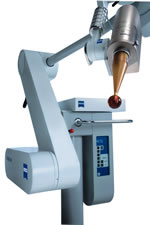Intraoperative radiation therapy (IORT)
Radiation meets surgery
IORT stands for Intraoperative Radiation Therapy: intra-operative because radiation is delivered during surgery, directly into the cavity where the tumor has just been removed. Most eligible patients won’t need to undergo any additional radiation therapy at a later date. As the first in Iowa to administer this procedure, UI Hospitals & Clinics uses an entire team of experts who customize their treatment for every patient, every time. It's one way that our teams use to "See Cancer Differently™."
Sonia Sugg, MD explains what IORT is, as well as the benefits and eligibility criteria of this unique procedure.
Benefits of IORT
- Saves time: The entire therapeutic dose of breast radiation is given immediately at the time of lumpectomy (removal of the tumor) while the patient is still under anesthesia. This allows the patient to complete the therapy sooner, allowing her to return to normal life more quickly.
- Convenience for patients: Traditionally, breast cancer patients would need to come back to undergo radiation therapy for five days a week for up to three to six weeks after they heal from surgery. For most patients who undergo IORT, there are typically no return trips for radiation.
- Targeted radiation therapy: Radiation is given directly and internally to the sections of the breast with the biggest risks of cancer reoccurrence.
- Team approach: The Radiation Oncologist is in the operating room with the surgeon.
- Decreased side effects: IORT has been found to decrease side effects such as red rashes and skin irritations when compared to traditional radiation therapy.
Candidates for IORT
Breast cancer patients who would normally undergo a lumpectomy followed by radiation are ideal candidates for IORT. Candidates typically:
- are in early stages of breast cancer.
- are over the age of 50.
- have small tumors.
Talk to your doctor to see if you are eligible.
Guidelines for Targeted Intraoperative Radiation Therapy Following Breast-conserving Surgery
The IORT procedure

Step 1
The surgeon removes the tumor, leaving a cavity where the tumor was located.

Step 2
The radiation oncologist places the applicator into the cavity.

Step 3
Radiation is given to the surrounding tissue for 20–30 minutes.

Step 4
The applicator is removed, and the surgeon closes the incision.
Returning to normal quickly
“I really didn’t have much discomfort following this treatment at all,” said Beverly Mueller, an IORT patient at University of Iowa Hospitals & Clinics. “There was a little tenderness but not even enough to take a pain pill. I was able to go back to work right away. I felt fine.”
“For the right person, we are offering an alternative that will allow a person to get back to their normal life, sooner,” said Ronald Weigel, MD, PhD, UI professor and head of surgery. A large clinical trial confirmed that delivering radiation at the time of a lumpectomy was as effective in preventing breast cancer recurrence as whole breast radiation therapy in selected patients.
Innovative technology
Your cancer treatment team at UI Hospitals & Clinics uses the INTRABEAM® system (shown below), developed by Carl Zeiss Meditec. Oncologists have a variety of applicator sizes to best fit the tumor bed cavity and deliver radiation directly to the area that needs it most.

Images Courtesy of Carl Zeiss Meditec